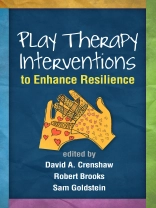The importance of therapeutic play in helping children recover from adversity has long been recognized. This unique volume brings together experts on resilience, trauma, and play therapy to describe effective treatment approaches in this key area. The book begins by providing guiding principles for intervention and describing the specific properties of play that promote resilience. Subsequent chapters delve into clinical applications, including such strategies as storytelling and metaphors, sand play, art therapy, play therapy adaptations for school settings, group interventions, and the use of therapeutic writing. Rich case studies and vignettes demonstrate creative ways to bolster at-risk children’s strengths and enhance their natural capacity to thrive.
Tabela de Conteúdo
I. Introduction
1. The Power of Mindsets: Guideposts for a Resilience-Based Treatment Approach , Robert Brooks & Sam Goldstein
2. Resilience-Enhancing Factors in Play Therapy, John W. Seymour
II. Clinical Applications
3. The Use of Metaphors and Storytelling Techniques to Nurture Resilience in Children, Robert Brooks & Suzanne Brooks
4. “Dear Mr. Leprechaun”: Nurturing Resilience in Children Facing Loss and Grief, David A. Crenshaw & Jillian E. Kelly
5. Posttraumatic Play: A Robust Path to Resilience, Eliana Gil
6. Calm, Connection, and Confidence: Using Art Therapy to Enhance Resilience in Traumatized Children, Cathy A. Malchiodi
7. Utilizing Strength-Based Strategies in the Schools: A School Psychologist’s Odyssey, Steven Baron
8. Enhancing Resilience through Play Therapy with Child and Family Survivors of Mass Trauma, Risë Van Fleet & Claudio Mochi
9. The Dance of Resilience and Attachment in High-Risk Mother–Infant Relationships, Stephanie Carnes & David A. Crenshaw
10. Playful Pathways to a Resilient Mindset: A Play Journey to Triumph over Adversity, Cherie L. Spehar
Sobre o autor
David A. Crenshaw, Ph D, ABPP, RPT-S, is Clinical Director of the Children’s Home of Poughkeepsie, New York, and Adjunct Faculty at Marist College. He has taught graduate courses in play therapy at Johns Hopkins University and Columbia University and has published widely on child and adolescent therapy, child abuse and trauma, and resilience in children. A Fellow of the American Psychological Association and of its Division of Child and Adolescent Psychology, Dr. Crenshaw has received lifetime achievement awards from the New York Association for Play Therapy and the Hudson Valley Psychological Association. He is a past chair of the board of directors of the Coalition against Sexual and Domestic Abuse and a member of the professional advisory board of the Courthouse Dogs Foundation and of the Dutchess County Task Force against Human Trafficking.
Robert Brooks, Ph D, ABPP, is Assistant Clinical Professor of Psychology in the Department of Psychiatry at Harvard Medical School and former Director of the Department of Psychology at Mc Lean Hospital. He has lectured nationally and internationally and written extensively about such topics as resilience, psychotherapy, and positive school and work environments. Dr. Brooks has coauthored or coedited numerous books with Sam Goldstein, including Handbook of Resilience in Children, Second Edition; Raising Resilient Children; and The Power of Resilience. He has received numerous awards in recognition of his work on behalf of children and their families, especially in the area of resilience.
Sam Goldstein, Ph D, is Assistant Clinical Instructor in the Department of Psychiatry at the University of Utah School of Medicine and on staff at the University Neuropsychiatric Institute. He is also Clinical Director of the Neurology, Learning, and Behavior Center in Salt Lake City. Dr. Goldstein is Editor-in-Chief of the Journal of Attention Disorders and serves on the editorial boards of six journals. He is author or editor of more than 50 books and 100 scholarly publications, as well as several psychological tests. He has lectured to thousands of professionals and the lay public in the United States, South America, Asia, Australia, and Europe.












